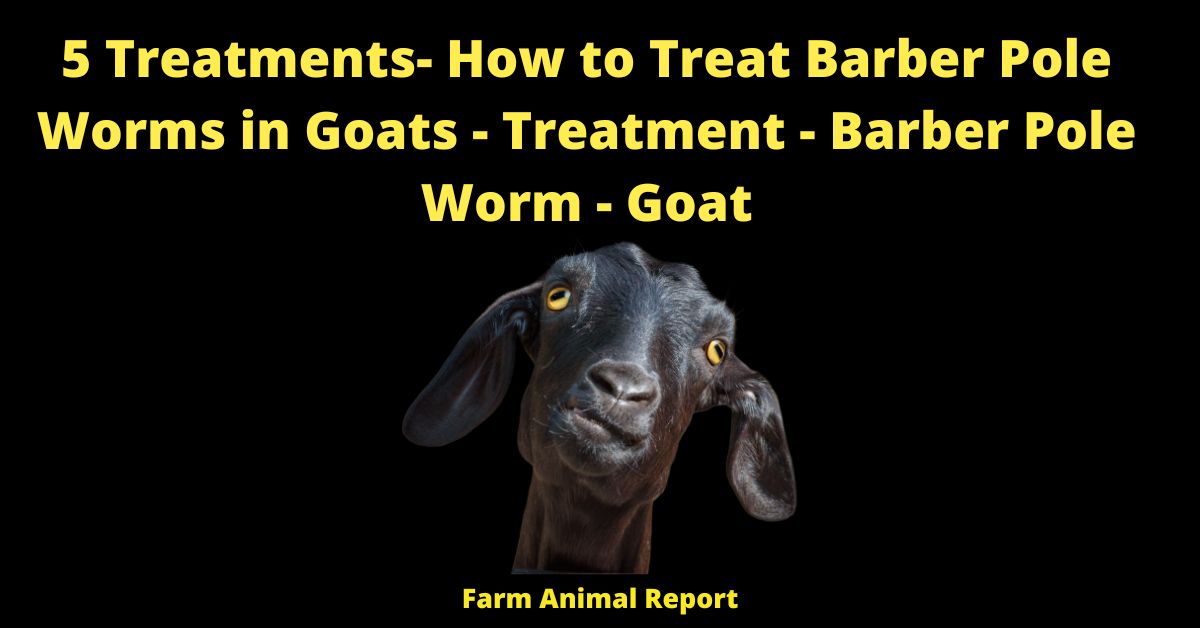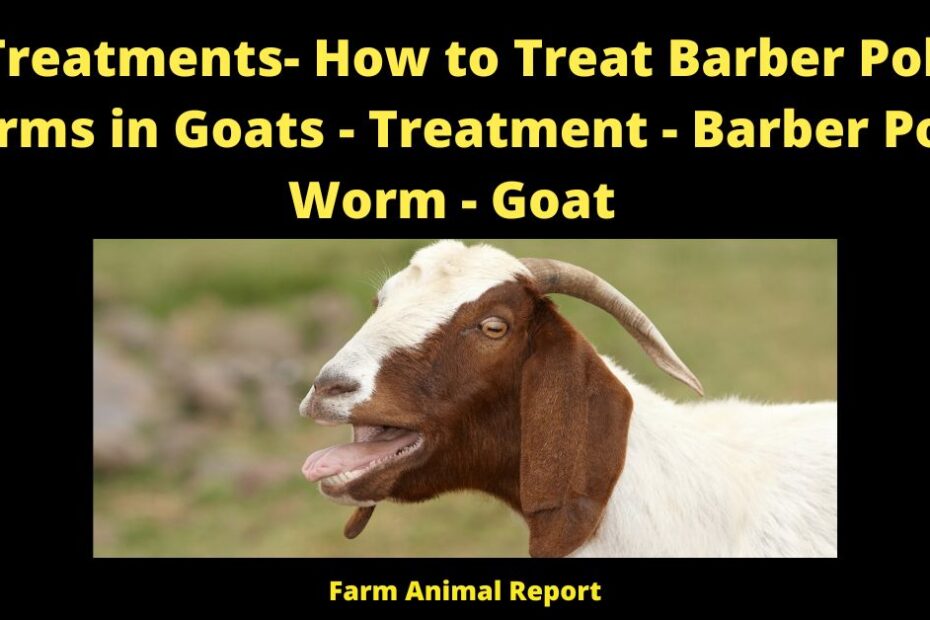If you’re a goat farmer, then you know how important it is to keep your goats healthy. One of the most common parasites that can affect goats is barber pole worms. These worms can cause serious health problems in your goats if they’re not treated properly. In this blog post, we’ll discuss how to treat barber Pole worms in goats, and we’ll give you some tips on how to prevent them from becoming a problem. how to treat barber pole worms in goats?
How to Treat Barber Pole Worms in Goats?
1. Prevention is the best approach to controlling barber pole worms. A good deworming program that includes strategic use of anthelmintics will help to reduce the number of infections.
2. Young animals are more susceptible to infection, so it is important to begin a control deworming program early on.
3. Adult goats that are routinely dewormed are less likely to become infected.
4. Barber pole worms can be difficult to detect, so it is important to perform regular fecal exams to look for evidence of the parasites.
5. If barber pole worms are detected, a treatment program that includes anthelmintics should be implemented.
6. The best time to treat barber pole worms is usually when animals are grazing on fresh, green pastures.
7. There are several different types of anthelmintics that can be used to treat barber pole worms, and the most appropriate drug should be selected based on the specific situation.
8. It is important to follow the label directions when using anthelmintics, and to never mix different drugs or dosages together without consulting a veterinarian first.
9. Dealing with an infestation of barber pole worms can be costly, so it is important to prevent these parasites from becoming a problem in the first place.
10. Some simple steps that can be taken to help reduce the risk of infection include: maintaining good sanitation practices, keeping animals well-grazed, and using an effective deworming program regularly.”

Life Cycle of Barber Pole Worms
- Barber Pole Eggs
- Pole Worm Larvae
The life cycle of the barber pole worm can be summarized in the following steps:
1. Adult female worms lay eggs in the feces.
2. Eggs develop into (rhabditiform), and juvenile stages by feeding on bacteria in the dung.
3. L1 stage usually occurs within four to six days under the optimal conditions of 24–29 °C (75–84 °F).
4. The L2 rhabditform sheds its cuticle and then develops into the L3 filariform infective larvae.
5. The L3 form has a protective cuticle, but under dry, hot conditions, survival is reduced.
6. Sheep, goats, and other ruminants become infected when they graze and ingest the L3 infective larvae.
7. The infective larvae pass through the first three stomach chambers to reach the abomasum.
8. There, the L3 shed their cuticles and burrow into the tissue where they develop into adult worms over a period of about two weeks.
What are the Symptoms of Barber Pole Worms in goats/ Sheep?
Barber pole worms, also calledHaemonchus contortus, are one of the most common and dangerous parasites of small ruminants. These intestinal worms cause anemia and weight loss in infected animals, and can even be fatal if left untreated.
Barber pole worms are especially harmful to young goats, who are more susceptible to infection and less able to fight off the parasites. Symptoms of barber pole worm infection include pale gums, weakness, lethargy, and diarrhea. If you suspect that your goat may be infected with barber pole worms, it is important to seek Veterinary care as soon as possible.
Treatment typically involves deworming medication and supportive care, such as fluids and blood transfusions. With prompt treatment, most goats make a full recovery from barber pole worm infection.
Can You see Barber Pole worms or eggs in Goat Poop?
Yes, Barber Pole worms or their eggs can be seen in goat poop. The Barber Pole worm, also known as the Haemonchus contortus, is a type of parasitic roundworm that commonly infects goats.
These worms feed on the blood of their host, causing anemia and illness. In severe cases, they can even be fatal. Adult Barber Pole worms lay their eggs in the intestine of their host, and these eggs are then passed out in the host’s feces.
So, if you see eggs in your goat’s poop, there is a good chance that they are Barber Pole worm eggs. If you suspect that your goat has Barber Pole worms, it is important to seek veterinary treatment as soon as possible
How to get rid of Barber Pole Worms in the Pasture?
Barber pole worms can wreak havoc on a pasture. The tiny creatures are actually nematodes, and they live inside the stomach of their host, which is usually a sheep. The worms feed on the blood of their host, and over time, this can lead to anemia and even death. The best way to get rid of these pests is to rotate your pasture. This means moving your flock to a new pasture every few months. The worms cannot survive in new soil, so this will eventually help to reduce their numbers. In addition, you can also use worming products that contain ivermectin or doramectin. These products are effective against Barber pole worms, and they can be administered either orally or through injections. With a little effort, you can successfully get rid of these dangerous pests.
5 Steps to Prevent Barber Pole Worms in Goats?
There are five main ways to prevent barber pole worms in goats: quarantine, pasture rotation, cleanliness, daisy chains, and worming.
- Quarantine is the process of separating new arrivals from the existing herd for a period of time. This allows any potential parasites time to exit the system before the animal is introduced to the rest of the population.
- Pasture rotation is another way to help prevent barber pole worm infestations. By moving goats to fresh pasture regularly, you can help reduce the number of larvae that mature into adult worms.
- Cleanliness is also important in preventing barber pole worm infestations. Be sure to clean out all waterers, feeders, and bedding areas on a regular basis. This will help to reduce the number of potential hosts for the larvae.
- Daisy chains are created when goats graze on pastures that have already been grazed by other animals. The parasites can be transmitted from one host to another, resulting in a continuous cycle of infection. To break this cycle, it is important to rotate animals between pastures on a regular basis.
- Worming is the process of using medication to kill parasites that are already present in the animal’s system. This should be done regularly as part of a preventative health program. In addition, goats should be tested for parasites on a regular basis so that treatment can be started early if an infestation is detected.
Methods to Treat barber Pole Worms in Goats?
There are many different methods that people use to treat Barber Pole Worms. Some people believe that the best way to treat them is through natural methods, while others argue that the use of chemicals is the only way to ensure that the worms are killed. Here are five of the most popular methods for treating Barber Pole Worms:
1) Fenbendazole: This is a medication that is commonly used to treat Barber Pole Worms. It works by killing the worms and their eggs, preventing them from multiplying.
2) Ivermectin: This is another medication that is commonly used to treat Barber Pole Worms. It works by paralyzing the worms, preventing them from moving and causing damage to the plant.
3) Neem oil: This is a natural oil that is extracted from the neem tree. It has properties that can kill insects, including Barber Pole Worms.
4) Diatomaceous earth: This is a substance that is made up of tiny fossilized algae. It works by puncturing the worms’ exoskeletons, causing them to dehydrate and die.
5) Copper sulfate: This is a chemical that can be used to kill Barber Pole Worms. It works by disrupting the worms’ metabolism, causing them to die.
- introduction grazing management
- drench resistance management
- resistance worm testing
- grazing management breeding
- worm control
Final Thoughts – How to Treat Barber Pole Worms in Goats (Treatment)
In summary, there are many different methods that can be used to treat Barber Pole Worms. Some people believe that natural methods are the best way to go, while others argue that the use of chemicals is the only way to ensure that the worms are killed. Ultimately, it is up to the individual to decide which method is best for their situation.





